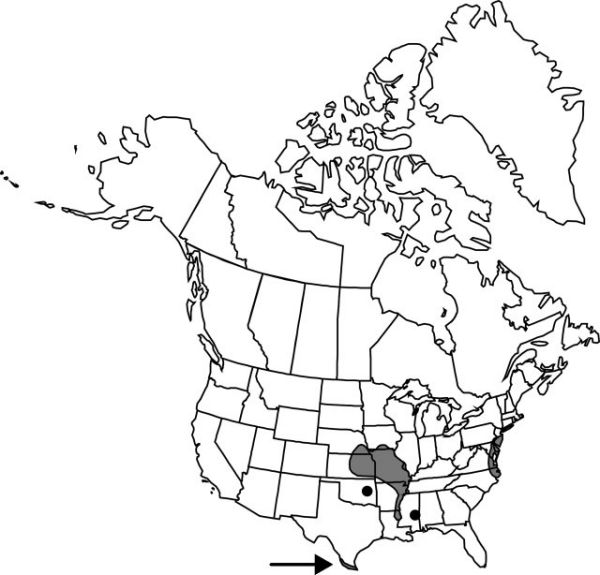Difference between revisions of "Heteranthera multiflora"
Phytologia 59: 290. 1986.
FNA>Volume Importer |
imported>Volume Importer |
||
| (6 intermediate revisions by 2 users not shown) | |||
| Line 7: | Line 7: | ||
|year=1986 | |year=1986 | ||
}} | }} | ||
| − | |basionyms={{Treatment/ID/ | + | |basionyms={{Treatment/ID/Basionym |
|name=Heteranthera reniformis var. multiflora | |name=Heteranthera reniformis var. multiflora | ||
|authority=Grisebach | |authority=Grisebach | ||
| + | |rank=variety | ||
| + | |publication_title=Abh. Königl. Ges. Wiss. Göttingen | ||
| + | |publication_place=24: 323. 1879 | ||
}} | }} | ||
|synonyms= | |synonyms= | ||
| Line 26: | Line 29: | ||
|elevation=0–1800 m | |elevation=0–1800 m | ||
|distribution=Ark.;Del.;Ill.;Iowa;Kans.;La.;Md.;Miss.;Mo.;Nebr.;N.J.;N.C.;Okla.;Pa.;Tenn.;Tex.;Va.;South America (Argentina;Brazil;Paraguay;Venezuela). | |distribution=Ark.;Del.;Ill.;Iowa;Kans.;La.;Md.;Miss.;Mo.;Nebr.;N.J.;N.C.;Okla.;Pa.;Tenn.;Tex.;Va.;South America (Argentina;Brazil;Paraguay;Venezuela). | ||
| − | |discussion=<p>This species has in the past been incorrectly identified as either Heteranthera reniformis (J. A. Steyermark 1963) or H. peduncularis (R. B. Kaul and C. N. Horn 1986). However, detailed study of development, floral morphology, and chromosome number revealed distinct differences (C. N. Horn 1985, 1988).</p><!-- | + | |discussion=<p>This species has in the past been incorrectly identified as either <i>Heteranthera reniformis</i> (J. A. Steyermark 1963) or H. peduncularis (R. B. Kaul and C. N. Horn 1986). However, detailed study of development, floral morphology, and chromosome number revealed distinct differences (C. N. Horn 1985, 1988).</p><!-- |
--><p>Three distinct genetic forms of this species exist, two in the flora range. Populations along the Atlantic coast have white flowers and inflorescences with most of the flowers within the spathe. Populations in the Great Plains have blue flowers and inflorescences with most flowers typically beyond the spathe. These populations have not been, nor should they be, recognized at any taxonomic level.</p> | --><p>Three distinct genetic forms of this species exist, two in the flora range. Populations along the Atlantic coast have white flowers and inflorescences with most of the flowers within the spathe. Populations in the Great Plains have blue flowers and inflorescences with most flowers typically beyond the spathe. These populations have not been, nor should they be, recognized at any taxonomic level.</p> | ||
|tables= | |tables= | ||
| Line 36: | Line 39: | ||
-->{{#Taxon: | -->{{#Taxon: | ||
name=Heteranthera multiflora | name=Heteranthera multiflora | ||
| − | |||
|authority=(Grisebach) C. N. Horn | |authority=(Grisebach) C. N. Horn | ||
|rank=species | |rank=species | ||
| Line 51: | Line 53: | ||
|publication year=1986 | |publication year=1986 | ||
|special status= | |special status= | ||
| − | |source xml=https:// | + | |source xml=https://bitbucket.org/aafc-mbb/fna-data-curation/src/2e0870ddd59836b60bcf96646a41e87ea5a5943a/coarse_grained_fna_xml/V26/V26_10.xml |
|genus=Heteranthera | |genus=Heteranthera | ||
|species=Heteranthera multiflora | |species=Heteranthera multiflora | ||
Latest revision as of 22:10, 5 November 2020
Plants annual. Vegetative stems submersed with elongate internodes, or emersed and procumbent. Flowering stems 1–4 cm, distal internode less than 1 cm. Sessile leaves alternate; blade linear to oblanceolate, thin, 37–70 × 4–6 mm, margins entire. Petiolate leaves floating or emersed; stipule 3–5 cm; petiole 5–15 cm; blade cordate, 2–5 × 2–5 cm, length usually greater than width, apex obtuse. Inflorescences spicate, 3–16-flowered, elongating in 1–2 days, longer than spathes (except on cleistogamous inflorescences); spathes 2–7 cm, glabrous; peduncle 4–11 cm, glabrous when emersed. Flowers opening ca. 2 hours after dawn, wilting early afternoon; perianth mauve or white, salverform, tube 3–12 mm, limbs zygomorphic, lobes narrowly elliptic, 3.3–5.9 mm, distal central lobe dark purple in basal 1/3, 2 yellow spots within dark area; stamens unequal, lateral stamens 1.3–2.4 mm, filaments linear, densely pubescent with purple multicellular hairs toward apex; central stamen 2.6–4 mm, filament sparsely pubescent with multicellular hairs; style pubescent with multicellular hairs. Seeds 9–12-winged, 0.6–0.9 × 0.4–0.5 mm. 2n = 32.
Phenology: Flowering Jul–Nov.
Habitat: Roadside ditches, pond edges
Elevation: 0–1800 m
Distribution

Ark., Del., Ill., Iowa, Kans., La., Md., Miss., Mo., Nebr., N.J., N.C., Okla., Pa., Tenn., Tex., Va., South America (Argentina, Brazil, Paraguay, Venezuela).
Discussion
This species has in the past been incorrectly identified as either Heteranthera reniformis (J. A. Steyermark 1963) or H. peduncularis (R. B. Kaul and C. N. Horn 1986). However, detailed study of development, floral morphology, and chromosome number revealed distinct differences (C. N. Horn 1985, 1988).
Three distinct genetic forms of this species exist, two in the flora range. Populations along the Atlantic coast have white flowers and inflorescences with most of the flowers within the spathe. Populations in the Great Plains have blue flowers and inflorescences with most flowers typically beyond the spathe. These populations have not been, nor should they be, recognized at any taxonomic level.
Selected References
None.